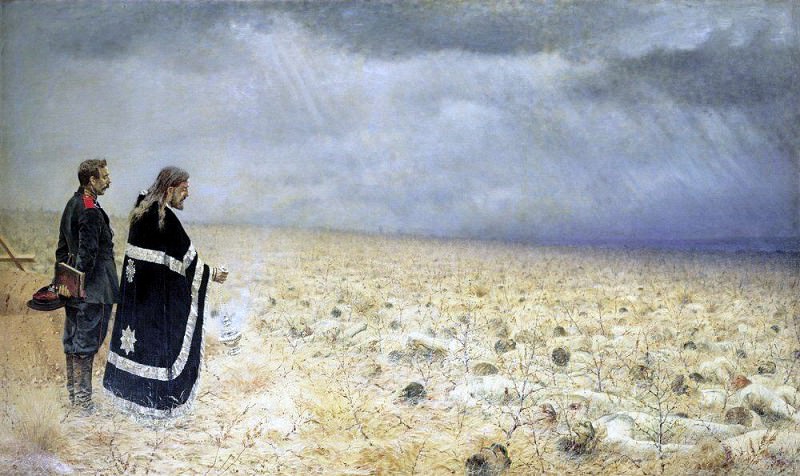Defeated. Dirge. 1878-1879 Vasily Vereshchagin (1842-1904)
Vasily Vereshchagin – Defeated. Dirge. 1878-1879
Edit attribution
Download full size: 1000×595 px (0,1 Mb)
Painter: Vasily Vereshchagin
"The Defeated. A Panikhida" belongs to the Balkan series of works by the artist Vereshchagin. It depicts the devastating consequences of the famous storming of the Bulgarian town of Plevna. For the Russian army, the consequences were expressed in huge human losses. By the time the painting was made, there was a trend in Russia to depict military parades and maneuvers. Unlike many artists, the war for Vereshchagin - it is always war.
Description of Vasily Vereshchagin’s painting "The Defeated. Memorial Service."
"The Defeated. A Panikhida" belongs to the Balkan series of works by the artist Vereshchagin. It depicts the devastating consequences of the famous storming of the Bulgarian town of Plevna. For the Russian army, the consequences were expressed in huge human losses.
By the time the painting was made, there was a trend in Russia to depict military parades and maneuvers. Unlike many artists, the war for Vereshchagin - it is always war. The great tragedy for millions of people, and not only the dead, but the survivors.
On the canvas depicts a huge field and the sky obscured by clouds. On the field lie the bodies of dead soldiers, slightly sprinkled with yellowish earth. The entire space, as far as can be seen, is occupied by the bodies of the dead, from the beginning of the field to the horizon. Vereshchagin was able to transfer a sense of melancholy, hopelessness and utter doom onto his canvas.
Near the field stand two men with uncovered heads. These are the commander, bidding farewell to the fallen soldiers, and the priest, serving a memorial service for them. Two of the living and an immense field of the dead.
The painting "Defeated. Funeral Service" is executed in subdued fall and summer colors: light blue, beige, various shades of brownish. These colors were chosen to emphasize the tragedy of the situation.
Contemporaries quite highly appreciated the design and execution of the work.
The canvas can evoke a dual feeling. Compassion for the fallen soldiers is one thing. Outrage that such a thing is possible at all is another. With works like this, the artist addresses both his contemporaries and future generations, showing them what the word "war" really means. Not only beautiful parades, heroism, and marches, but also fields like these, strewn with corpses. This is the opinion of Vereshchagin, a Russian officer who went through many wars in the second half of the 19th century and died in the Russian-Japanese Navy.
Кому понравилось
Пожалуйста, подождите
На эту операцию может потребоваться несколько секунд.
Информация появится в новом окне,
если открытие новых окон не запрещено в настройках вашего браузера.
You need to login
Для работы с коллекциями – пожалуйста, войдите в аккаунт (open in new window).




















COMMENTS: 3 Ответы
Картина великолепная...
художник передал всё:мысли, чувства обстановку:)
На Руси изревле не принято хоронить воинов.
Это реальное событие. Место село Телиш (сейчас в Болгарии). На то место сейчас есть 6 братских могил.
You cannot comment Why?
The field itself is littered with numerous mounds of earth, or perhaps shallow graves. Scattered amongst these mounds are fragmented human forms, seemingly bodies. The colors are muted and somber, dominated by grays, browns, and pale yellows, accentuating the sense of tragedy and loss. Light rays pierce through the heavy clouds in the distance, offering a faint, almost hopeful, contrast to the grimness of the scene.
The subtext of the painting is deeply tied to the grim realities of war and its aftermath. The title, Defeated. Dirge., explicitly points to a military defeat and a lament for the fallen. The presence of the clergyman and the military figure suggests an acknowledgment of the loss, with the clergyman performing rites for the dead and the soldier perhaps representing the defeated army or an observer of the tragedy. The scattered bodies and the desolate landscape evoke the senselessness of war and the immense human cost. The title Dirge itself implies a mournful song or lament, further emphasizing the sorrow and grief associated with the scene. The painting serves as a powerful commentary on the devastating consequences of conflict, focusing on the sorrow and spiritual reflection that follow a military defeat.